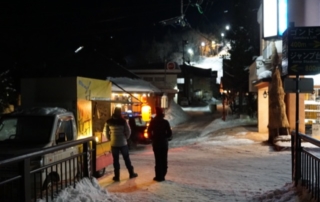Jim Ivanoff | ivanoff@bcwood.jp
With the Winter Olympics happening now in PyeongChang, it is a good time to think back to a former host, Nagano, Japan. Most Canadians may not want to remember those 1998 Games as they saw the first Canadian ice hockey “dream team” turn in a nightmare performance, missing the podium completely. However, it seems that the venue for the downhill ski events, Hakuba, left a lasting impression on Australian skiers.
Niseko in Hokkaido has become famous as the first successful international ski resort in Japan. In some ways, Niseko has become a victim of its own success with its Japan leading appreciation in real estate values now making would be investors look at other areas. Based on its Olympic heritage, Hakuba became an alternative several years ago, but it seems to have now become a major destination.
I had not been to the area in winter for many years, so on a recent trip I was surprised to find a once sleepy post-Olympic resort teeming with foreigners again. The vast majority seemed to be Australian, but there were also Europeans and North Americans as well as Southeast Asians and Chinese in the mix. Many of the workers on the slopes were also foreigners. Speaking with local business people, I was told that if it were not for the inbound tourists, the town would be dead.
Hakuba’s biggest problem has always been access. There are many ski resorts with bullet train access from Tokyo, but the hike to Hakuba requires 4-5 hours with a combination of trains and/or buses. That is probably one of the main reasons why Japanese skiers have stayed away.
However, looking at it from a foreign traveler’s perspective, I could see Hakuba’s appeal. Located in the Japanese Alps, the area is blessed with snow and more significant mountains than other parts of the country. Also, there at least half a dozen ski hills in the Hakuba Valley so a visitor staying for week could easily ski a different resort each day. While Niseko is unquestionably the powder king, all of the slopes are on different faces of a single volcano.
From a development perspective, the valley also helps create boundaries of how the resort can develop which in the future could help drive land values. While completely under-developed, the area around the base of the main Olympic venue, Happo-one, already acts as a village centre with local restaurants and lodgings such as small hotels and B&Bs. Beyond this main village, there are many subdivisions full of cottages of various vintages.
While seeing and feeling the potential for development, it is also obvious that there is still a lot of work to be done before Hakuba could become a world-class resort. However, there are already foreigners developing resort homes and even condos. There is also talk of major foreign hotel chains looking for land in the area. In this and many other ways, it very much reminds me of Niseko when I first visited there about 10 years ago. There are many interesting areas around Japan that will see significant redevelopment in the next few years, but Hakuba is clearly one to be watched closely.
Please contact us for more information on how your company can get directly involved in this exciting time in Japan.

